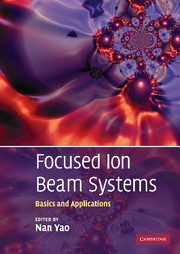Book contents
- Frontmatter
- Contents
- List of contributors
- Preface
- 1 Introduction to the focused ion beam system
- 2 Interaction of ions with matter
- 3 Gas assisted ion beam etching and deposition
- 4 Imaging using electrons and ion beams
- 5 Characterization methods using FIB/SEM DualBeam instrumentation
- 6 High-density FIB-SEM 3D nanotomography: with applications of real-time imaging during FIB milling
- 7 Fabrication of nanoscale structures using ion beams
- 8 Preparation for physico-chemical analysis
- 9 In-situ sample manipulation and imaging
- 10 Micro-machining and mask repair
- 11 Three-dimensional visualization of nanostructured materials using focused ion beam tomography
- 12 Ion beam implantation of surface layers
- 13 Applications for biological materials
- 14 Focused ion beam systems as a multifunctional tool for nanotechnology
- Index
- References
11 - Three-dimensional visualization of nanostructured materials using focused ion beam tomography
Published online by Cambridge University Press: 12 January 2010
- Frontmatter
- Contents
- List of contributors
- Preface
- 1 Introduction to the focused ion beam system
- 2 Interaction of ions with matter
- 3 Gas assisted ion beam etching and deposition
- 4 Imaging using electrons and ion beams
- 5 Characterization methods using FIB/SEM DualBeam instrumentation
- 6 High-density FIB-SEM 3D nanotomography: with applications of real-time imaging during FIB milling
- 7 Fabrication of nanoscale structures using ion beams
- 8 Preparation for physico-chemical analysis
- 9 In-situ sample manipulation and imaging
- 10 Micro-machining and mask repair
- 11 Three-dimensional visualization of nanostructured materials using focused ion beam tomography
- 12 Ion beam implantation of surface layers
- 13 Applications for biological materials
- 14 Focused ion beam systems as a multifunctional tool for nanotechnology
- Index
- References
Summary
Introduction
One of the fundamental goals of materials science is to establish structure property relationships. Historically, structure property relationships in materials have been established with great success using imaging and spectroscopic methods that measure signals that vary in one and two dimensions. For example, X-ray and neutron diffraction techniques are typically used to measure average physical and crystallographic properties of relatively large volumes of material. While different modes exist for these techniques such as spot modes and surface reflectance modes, they effectively average over volumes of materials properties and produce information that varies in at most two-dimensions. Auger electron spectroscopy (AES) and secondary ion mass spectroscopy (SIMS), while capable of high spatial resolution in surface mapping modes and depth profiling modes, are traditionally used to produce maps and profiles in one and two dimensions.
High-resolution imaging techniques, such as scanning and transmission electron microscopy, generally produce two-dimensional real space intensity maps of surfaces or an image that has been averaged through a sample thickness, as is the case in conventional transmission electron microscopy.
Scanning probe microscopy techniques, such as atomic force microscopy and scanning tunneling microscopy, may be regarded as providing a measure of surface variation in three dimensions. In particular, both techniques are capable of measuring in-plane variations in position with near atomic scale lateral resolution as well as sub-atomic scale measurements parallel to a local surface normal. These scanning probe techniques are limited to surface measurements, however, and in general cannot directly measure sub-surface information.
- Type
- Chapter
- Information
- Focused Ion Beam SystemsBasics and Applications, pp. 295 - 317Publisher: Cambridge University PressPrint publication year: 2007

